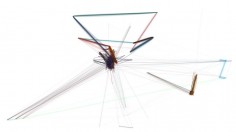BENJAMIN GROSSER
Computers Watching Movies
(2001: A Space Odyssey)
source: bengrosser
Artist and composer Benjamin Grosser focuses on the cultural, social, and political effects of software. What does it mean for human creativity when a computational system can paint its own artworks? How is an interface that foregrounds our friend count changing our conceptions of friendship? Why do we become emotionally attached to software systems and what does this attachment enable for those who made them? To examine questions like these, he constructs interactive experiences, machines, and systems that make the familiar unfamiliar, revealing the ways that software prescribes our behavior and thus, how it changes who we are.
Grosser’s artworks have been featured in Wired, The Atlantic, The Guardian, the Los Angeles Times, Slate, Creative Applications Network, Neural, Rhizome, Make, FastCoDesign, Gizmodo, Engadget, Corriere della Sera, El País, Der Spiegel, and The New Aesthetic. The Huffington Post said of his Interactive Robotic Painting Machine that “Grosser may have unknowingly birthed the apocalypse.” The Chicago Tribune called him the “unrivaled king of ominous gibberish.” His Facebook Demetricator was part of Public Assembly at The White Building in London and The Public Private at Parsons in New York curated by Christiane Paul. Grosser’s latest work, ScareMail, was recently part of PRISM Breakup at Eyebeam in New York and the London CryptoFestival at Goldsmiths. Grosser’s Computers Watching Movies will soon be part of COLLISION20 at the Boston Cyberarts Gallery. His recent recognitions include curation into the Rhizome ArtBase and awards from Terminal and Creative Divergents.
Grosser’s sound synthesis research was funded by the Illinois Campus Research Board and received an Arnold O Beckman Award. His scientific visualizations have been screened at SIGGRAPH and honored by the National Science Foundation. His research into imaging, virtual instrumentation, and telepresence received NASA’s Software Award, and was covered by the New York Times and National Public Radio.
Grosser holds an MFA in new media and an MM in music composition from the University of Illinois at Urbana-Champaign, where he now teaches in the School of Art & Design.
Computers Watching Movies shows what a computational system sees when it watches the same films that we do. The work illustrates this vision as a series of temporal sketches, where the sketching process is presented in synchronized time with the audio from the original clip. Viewers are provoked to ask how computer vision differs from their own human vision, and what that difference reveals about our culturally-developed ways of looking. Why do we watch what we watch when we watch it? Will a system without our sense of narrative or historical patterns of vision watch the same things?
Computers Watching Movies was computationally produced using software written by the artist. This software uses computer vision algorithms and artificial intelligence routines to give the system some degree of agency, allowing it to decide what it watches and what it does not. Six well-known clips from popular films are used in the work, enabling many viewers to draw upon their own visual memory of a scene when they watch it. The scenes are from the following movies: 2001: A Space Odyssey, American Beauty, Inception, Taxi Driver, The Matrix, and Annie Hall.


